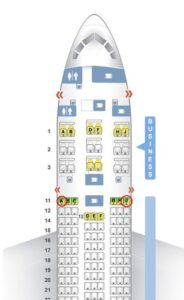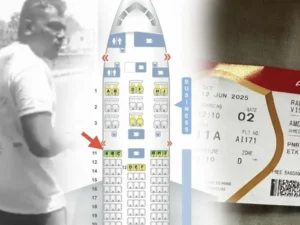On June 12, 2025, two brothers from Leicester, UK, boarded Air India Flight AI171 in Ahmedabad, their hearts light with the joy of a family visit in their ancestral homeland of Gujarat. Vishwash Kumar Ramesh, 40, settled into seat 11A, an emergency exit row window seat, while his younger brother, Ajay Kumar Ramesh, 35, took seat 11J across the aisle, another window seat. The London-bound Boeing 787-8 Dreamliner, carrying 242 passengers and crew, promised a routine journey home. But 32 seconds after takeoff from Sardar Vallabhbhai Patel International Airport, a catastrophic failure sent the plane crashing into a medical hostel in Meghaninagar, killing 241 aboard and at least 24 on the ground. Vishwash, in a near-impossible feat, emerged from the wreckage, bloodied but alive—the sole survivor. Ajay, just meters away, perished in the inferno. Their story, a heart-wrenching blend of miracle and tragedy, has gripped the world, embodying the cruel randomness of fate.
A Journey Home
Vishwash and Ajay Ramesh, born in Diu, India, had built lives in Leicester, where their family ran a now-defunct textile business. Vishwash, a reserved businessman with a wife and young son, and Ajay, a charismatic entrepreneur, had traveled to Gujarat for a mix of personal and business matters, visiting relatives in Diu and Ahmedabad. Their trip was filled with laughter—shared meals with cousins, temple visits, and late-night talks about their childhood. On June 12, they checked in at Ahmedabad’s airport, their suitcases packed with gifts and memories. Vishwash, always cautious, chose seat 11A for its legroom, while Ajay, ever relaxed, took 11J, joking about the better view from his side.

Flight AI171 was a diverse microcosm, carrying 169 Indian nationals, 53 British citizens, seven Portuguese, and one Canadian. Among the passengers were former Gujarat Chief Minister Vijay Rupani, a family of five chasing a new life, and young cabin crew members from Manipur. The aircraft, a 12-year-old Boeing 787-8 with over 41,000 flight hours, was piloted by Captain Sumeet Sabharwal, with 8,200 hours, and First Officer Clive Kundar, with 1,100 hours. At 1:38 p.m. local time, the plane roared down runway 23, its GE Aerospace GEnx-1B engines humming under clear skies. The brothers, seated across the aisle, exchanged a final smile, unaware that their fates would diverge in seconds.
A Cataclysm in the Skies
Less than a minute after takeoff, at 625 feet, the plane shuddered. A loud bang echoed through the cabin, followed by a “Mayday” call from the cockpit, signaling a life-threatening emergency. Videos later showed the aircraft struggling, its nose pitched upward, landing gear extended, and flaps possibly retracted, unable to climb. It veered sharply and plummeted into the BJ Medical College hostel, a residence for doctors and students, just 600 meters from the runway. The impact unleashed a fireball, as 125,000 liters of fuel ignited, obliterating the hostel’s canteen and engulfing the building in flames. Debris scattered across Meghaninagar, with the plane’s tail protruding grotesquely from the wreckage, a haunting image seared into global consciousness.
The crash killed 241 of the 242 aboard, including Ajay Ramesh in seat 11J, and at least 24 ground victims—five medical students, a doctor’s spouse, and others caught in the lunch-hour chaos. Rescue teams, including the Indian Army and firefighters, battled intense heat to recover over 290 bodies, many requiring DNA identification due to severe burns. Fifty hostel residents were hospitalized, some with critical injuries from leaping out of windows to escape the blaze. The disaster, India’s worst single-aircraft crash since 1996, left a city and nation in shock.

The Miracle of Seat 11A
Vishwash Kumar Ramesh’s survival is nothing short of miraculous. Seated in 11A, an emergency exit row just ahead of the wing’s structural spar, he was in one of the plane’s most fortified areas. The seat’s proximity to an emergency door allowed him to escape as the aircraft disintegrated. Vishwash later recalled a violent jolt, the pilot’s distressed “Mayday,” and a rush of heat as he leaped from the plane, possibly before or during the impact. Bloodied and disoriented, he staggered from the wreckage, his white shirt stained with blood, and was guided to an ambulance by a bystander. Videos captured his limping figure, a lone survivor amid the chaos, clutching his boarding pass as if it tethered him to reality.

From his bed at Ahmedabad Civil Hospital, Vishwash described the ordeal, his voice heavy with trauma. “Thirty seconds after takeoff, there was a loud bang, and the plane fell,” he said, his eyes swollen from smoke and debris. “I woke up surrounded by bodies and metal. I was terrified, but I ran.” Doctors reported impact injuries to his chest, eyes, and feet, but his condition was stable, with a physical recovery expected within days. Emotionally, however, the loss of Ajay, seated just across the aisle, has left him shattered. “I kept shouting for Ajay, but I couldn’t find him,” he said, unaware that his brother was among the victims.
The Tragedy of Seat 11J
Ajay Ramesh, seated in 11J, had no such miracle. Positioned on the opposite side of the aisle, his window seat offered no access to an emergency exit, and the crash’s ferocity left little chance of survival. The fireball that engulfed the cabin likely claimed him instantly, a cruel twist for a man described by family as the life of every gathering. Vishwash’s desperate search for Ajay in the wreckage, captured in his hospital pleas—“Find Ajay, you must find him”—has broken hearts worldwide. The Ramesh family, gathered in Leicester, clung to hope as Ajay’s phone rang for hours, but confirmation of his death extinguished their prayers.
Nayan Kumar Ramesh, the brothers’ 27-year-old sibling, spoke of the family’s torment from their Leicester home. “It’s a miracle Vishwash survived, but losing Ajay is unbearable,” he said, gesturing to their sobbing mother, Manibai. The family, rooted in Leicester’s tight-knit Gujarati community, faces a dual reality: gratitude for one son’s life and grief for another’s loss. Vishwash’s wife and son, awaiting his return, now prepare for a reunion tinged with sorrow, while Ajay’s absence leaves a void in their close-knit clan.
A Nation and World Respond
India mourned the tragedy, its deadliest aviation disaster in decades. Prime Minister Narendra Modi, a Gujarat native, visited the crash site, consoling families and meeting Vishwash in the hospital. Home Minister Amit Shah and Civil Aviation Minister Ram Mohan Naidu oversaw rescue and medical efforts, with over 260 bodies recovered. Air India, under Tata Group ownership, offered ₹1 crore (approximately $116,000) per victim’s family and set up support centers in Ahmedabad, Mumbai, Delhi, and Gatwick. The airline suspended operations at Ahmedabad airport, its social media darkened in respect.
Internationally, leaders expressed solidarity. U.S. President Donald Trump pledged investigative support, with the National Transportation Safety Board joining India’s Aircraft Accident Investigation Bureau (AAIB). British Prime Minister Keir Starmer and King Charles III mourned the 53 British victims, including a Gloucester family and a Blackburn couple. The AAIB, alongside Boeing and GE Aerospace, is analyzing the recovered Flight Data Recorder, probing theories like bird strikes, engine failure, or flap issues. The Cockpit Voice Recorder, still missing, may clarify the pilots’ actions.
Investigating the Disaster
The crash, the first fatal incident for the Boeing 787 Dreamliner, has shaken the aviation industry. Videos suggest the plane failed to climb, with extended landing gear and possibly retracted flaps, hinting at a configuration error or mechanical fault. The hostel’s proximity to the airport has sparked calls for stricter zoning, as urban sprawl encroaches on safety buffers. Air India’s maintenance and pilot training are under scrutiny, despite its recent modernization. Boeing, already facing 737 MAX controversies, confronts new pressure, with its CEO canceling public appearances to focus on the crisis.
Online, the brothers’ story has resonated deeply. Social media posts describe Vishwash’s survival as “a miracle of fate,” while Ajay’s loss in 11J is mourned as “a cruel twist.” Users share images of the crash site, the tail protruding from the hostel, and Vishwash’s bloodied figure, calling the contrast between 11A and 11J “a story of life and death.” The Ramesh family’s grief, amplified by Vishwash’s hospital pleas, has inspired prayers and reflection on life’s fragility.
A Tale of Two Seats
In Leicester, the Ramesh family’s home is a place of quiet sorrow and fragile hope. Vishwash’s survival, a testament to the structural fortuity of seat 11A, is a miracle that defies logic. Yet, Ajay’s loss in 11J, just meters away, underscores the randomness of fate. The brothers, inseparable in life, were divided by a crash that spared one and claimed the other. Vishwash, recovering physically, faces an emotional journey marked by guilt and loss, his calls for Ajay echoing in the hearts of those who hear his story.
Ahmedabad, resilient yet scarred, honors its victims while celebrating its survivors. The medical students who escaped the hostel, the responders who braved flames, and families like the Ramesh clan embody a collective strength. As investigators seek answers, the world watches, hoping to prevent such a tragedy again. The tale of seats 11A and 11J, a miracle and a tragedy intertwined, reminds us that life can hinge on a single moment, a single seat, a single twist of fate.


